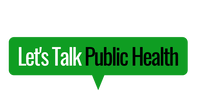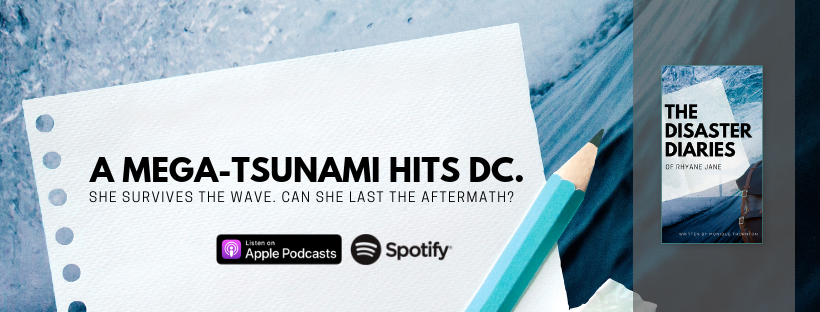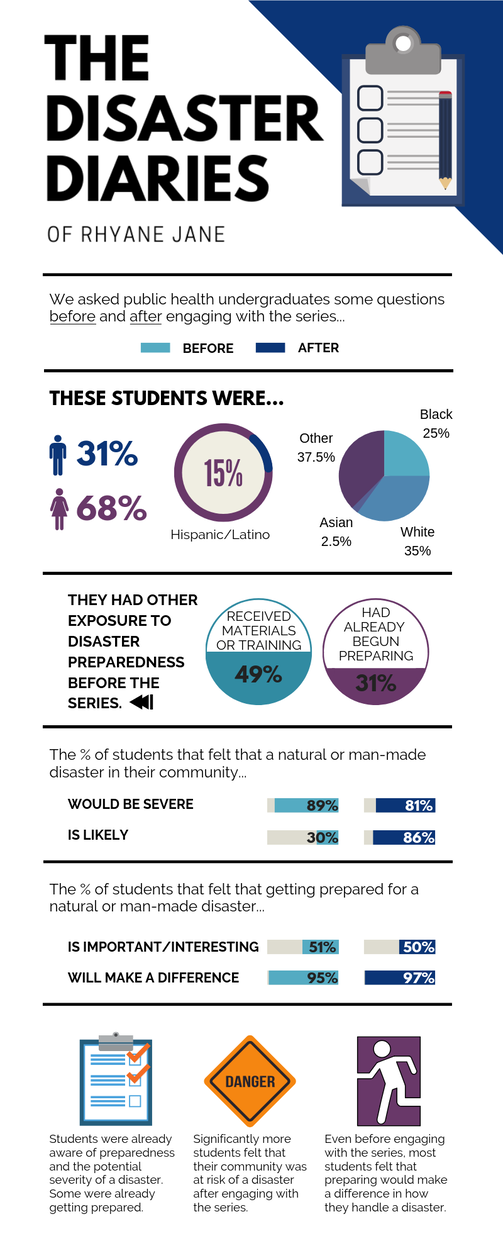What is The Disaster Diaries of Rhyane Jane?
It’s the first media production of Let’s Talk Public Health, and we’re absolutely and completely excited about it. The Disaster Diaries of Rhyane Jane (DDRJ) is an edutainment web series that includes:
The DDRJ is also active on Facebook and Twitter. In addition to sharing promotional videos for each of the podcast episodes and links to the latest blog posts, we share tips and information about preparedness that are posted by Ready.gov, FEMA, Red Cross and other emergency preparedness and disaster response organizations.
How is this edutainment?
The idea of the series is to engage people around disaster and emergency preparedness in an entertaining way. DDRJ is not only an entertainment production, but is also a theoretically-based social marketing tool.
The serial fiction podcast format aligns with Narrative Transportation Theory. According to this communication theory: The more people are transported into a narrative (in other words the more immersed they are in a story), the less engaged they are in their real-world knowledge, attitudes, and beliefs, and the more likely they are to shift their attitudes, intentions, and behaviors to align with the story.
Stories provide a way to engage people cognitively and emotionally; but, for there to be any change or shift in attitudes or behavior, the story has to be good. A good story has characters that people can empathize with, a plot that is believable, and a description that allows people to imagine the world of the story. The more people are involved with the story, the less they create counterarguments to the attitudes, beliefs, and behaviors in that story.
Because this theory is the basis of the podcast, during the writing process, the story (i.e., the plot lines, character development, etc.) has always come first. There is no set list of health messages around which each episode of the podcast is written. Instead, with each episode, there has been hours of research to inform and enrich the contextual details of the story. For the story to be able to evoke strong mental imagery, and thus facilitate deeper immersion, there is a need to understand what a post mega-tsunami world would look like at any given time. With a better understanding of what’s going on in that world as the days pass, it's easier to compose the characters' experiences of that world, establish plot lines, and map out character arcs. In addition to good plot and character development, on the technical side, the production quality has to meet the standards of listeners. Poor production quality can distract from the story and impede immersion. Using professional-grade audio recording equipment helps ensure quality recordings. Furthermore, prudent editing helps deliver high quality episodes. If any segment of an episode doesn't sound right (e.g., the tone or cadence is off or words are mispronounced or difficult to understand), that segment is re-recorded. The words can’t sound rushed or forced; there needs to be a natural flow with diction that evokes the appropriate emotions. It’s an iterative process, but the end product is optimized--in a sense--to engage listeners, connect with them, and immerse them. To accompany the podcast episode are blog posts that provide additional tips and information. Each blog post discusses either an item that came up in a podcast episode or a tip that aligns with the plot of the story. These posts supplement the podcast by providing the how-to information for implementing preparedness activities. The blog post content addresses several cross-cutting constructs of behavior change theory, including the following:
Is this web series effective at changing attitudes and/or behavior?
We conducted an exploratory pre- and post-survey (adapted from the FEMA Preparedness in America survey) with some undergraduates on the first three episodes of the podcast and the following blog posts to test this question:
The results of this survey are included in the infographic below. Key points include the following:
Is the shift in perceived risk to disasters enough to increase preparedness activity? More research is needed. It's also important to note that these public health students are not representative of the general population. Almost half of the students were already exposed to information about preparedness before engaging with the series, and a third of the students had already begun preparing for disasters. A more formal research study, with a representative sample, would tell us more about the effectiveness of this type of social marketing product. What have been your experiences with social marketing via narrative products? Drop us a line.
0 Comments
Your comment will be posted after it is approved.
Leave a Reply. |
�
Learn about our blog submission guidelines. >>
The views and opinions expressed by individual authors on this blog are their own and do not necessarily reflect the official policy or position of Let's Talk Public Health.
Categories
All
|
||||||||
|
Highlights
Explore
Connect
|



 RSS Feed
RSS Feed